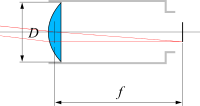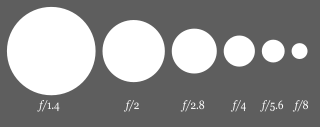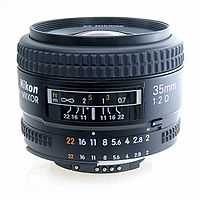Telescopes and cameras

 is the focal length and
is the focal length and  is the diameter of the objective lens. Credit: .
is the diameter of the objective lens. Credit: ."In most photography and all telescopy, where the subject is essentially infinitely far away, longer focal length (lower optical power) leads to higher magnification and a narrower angle of view; conversely, shorter focal length or higher optical power is associated with a wider angle of view."[1]
Evaluation
|
Problem 1

"For the case of a [double-convex] lens of thickness d in air, and surfaces with radii of curvature R1 and R2, the effective focal length f is given by:
where n is the refractive index of the lens medium. The quantity 1/f is also known as the optical power of the lens."[1]
What is the formula for a plano-convex lens?
Calculate the focal length of a double convex lens in which R1 = 10 m and R2 = 200 m. Let n = 1.732 and d = 2 cm.
What is the focal length of a hemispherical plano-convex lens of radius 10 m? Let n= 1.324 and d = 1 dm.
What is a likely focal length for a plano-convex lens where the convex surface is parabolic rather than spherical?
Problem 2

For a focal length of 100 mm, what are the aperture or entrance pupil diameters for each of the apertures shown if no optical components are between the entrance pupil and the aperture?
For a simple camera or telescope with an aperture lens diameter of 5 m, what is the focal length for each of the apertures or entrance pupil diameters in the diagram if no optical components are between the entrance pupil and the aperture?
For the following pairs of focal lengths and lens diameters, what would be the f-numbers? (a) 5 m, 3 m (b) 10 m, 3 mm (c) 50 cm, 2 m (d) 15 km, 25 m (e) 5,000 km, 16 cm.
Problem 3

 , as indicated by the white dot above the f-stop scale on the aperture ring. Credit: .
, as indicated by the white dot above the f-stop scale on the aperture ring. Credit: .The lens in the image at right has an aperture range of  to
to 
The image lens at right uses "a standard f-stop scale, which is an approximately geometric sequence of numbers that corresponds to the sequence of the powers of the square root of 2: 







 [and]
[and]  "[2]
"[2]
"The sequence above is obtained by approximating the following exact geometric sequence:"[2]
What are the missing terms?
"Each "stop" is marked with its corresponding f-number, and represents a halving of the light intensity from the previous stop. This corresponds to a decrease of the pupil and aperture diameters by a factor of 1/ or about 0.7071, and hence a halving of the area of the pupil."[2]
or about 0.7071, and hence a halving of the area of the pupil."[2]
For a lens diameter of 35 mm, what is the focal length for each f-stop?
Problem 4
"[S]hutter speeds are arranged so that each setting differs in duration by a factor of approximately two from its neighbour. Opening up a lens by one stop allows twice as much light to fall on the film in a given period of time. Therefore to have the same exposure at this larger aperture as at the previous aperture, the shutter would be opened for half as long (i.e., twice the speed). The film will respond equally to these equal amounts of light, since it has the property of reciprocity. This is less true for extremely long or short exposures, where we have reciprocity failure. Aperture, shutter speed, and film sensitivity are linked: for constant scene brightness, doubling the aperture area (one stop), halving the shutter speed (doubling the time open), or using a film twice as sensitive, has the same effect on the exposed image."[2]
"[S]hutter speed or exposure time is the length of time a camera's shutter is open when taking a photograph.[3] The amount of light that reaches the film or image sensor is proportional to the exposure time."[4]
"Exposure value (EV) is a single quantity that accounts for the shutter speed and the f-number."[4]
"Multiple combinations of shutter speed and f-number can give the same exposure value."[4]
"Doubling the exposure time doubles the amount of light (subtracts 1 EV). Making the f-number one stop brighter (reducing the f-number by a factor of  ) also doubles the amount of light. A shutter speed of 1/50 s with an
) also doubles the amount of light. A shutter speed of 1/50 s with an  lens gives the same exposure value as a 1/100 s shutter with an {
lens gives the same exposure value as a 1/100 s shutter with an { lens, and also the same exposure value as a 1/200 s shutter with an
lens, and also the same exposure value as a 1/200 s shutter with an  lens."[4]
lens."[4]
A "standardized 2:1 scale ... for shutter speed [is such] that opening one aperture stop and reducing the shutter speed by one step resulted in the identical exposure. The ... standards for shutter speeds are:[5]"[4]
- 1/16000 s
- 1/12000 s
- 1/8000 s
- 1/4000 s
- 1/2000 s
- 1/1000 s
- 1/500 s
- 1/250 s
- 1/125 s
- 1/60 s
- 1/30 s
- 1/15 s
- 1/8 s
- 1/4 s
- 1/2 s
- 1 s
What are the other f-numbers that match the shutter speeds?
"[E]xposure value (EV) is a number that represents a combination of a camera's shutter speed and f-number, such that all combinations that yield the same exposure have the same EV value (for any fixed scene luminance). Exposure value also is used to indicate an interval on the photographic exposure scale, with 1 EV corresponding to a standard power-of-2 exposure step, commonly referred to as a stop."[6]
"Exposure value is a base-2 logarithmic scale [...]:
where
- N is the relative aperture (f-number)
- t is the exposure time (“shutter speed”) in seconds".[6]
"In a mathematical expression involving physical quantities, it is common practice to require that the argument to a transcendental function (such as the logarithm) be dimensionless. The definition of EV ignores the units in the denominator and uses only the numerical value of the exposure time in seconds; EV is not the expression of a physical law, but simply a number for encoding combinations of camera settings."[6]
Match up the shutter speeds with f-numbers to give the same EV.
Research
Hypothesis:
- Alternate title could be Radiation telescopes/Problem set.
Control groups

The findings demonstrate a statistically systematic change from the status quo or the control group.
“In the design of experiments, treatments [or special properties or characteristics] are applied to [or observed in] experimental units in the treatment group(s).[7] In comparative experiments, members of the complementary group, the control group, receive either no treatment or a standard treatment.[8]"[9]
Proof of concept
Def. a “short and/or incomplete realization of a certain method or idea to demonstrate its feasibility"[10] is called a proof of concept.
Def. evidence that demonstrates that a concept is possible is called proof of concept.
The proof-of-concept structure consists of
- background,
- procedures,
- findings, and
- interpretation.[11]
Proof of technology
"[T]he objective of a proof of technology is to determine the solution to some technical problem, such as how two systems might be integrated or that a certain throughput can be achieved with a given configuration."[12]
Def.
- "[a]n original object or form which is a basis for other objects, forms, or for its models and generalizations",[13]
- "[a]n early sample or model built to test a concept or process",[13] or
- "[a]n instance of a category or a concept that combines its most representative attributes"[13] is called a prototype.
Def. "[t]o test something using the conditions that it was designed to operate under, especially out in the real world instead of in a laboratory or workshop"[14] is called "field-test", or a field test.
A "proof-of-technology prototype ... typically implements one critical scenario to exercise or stress the highest-priority requirements."[15]
"[A] proof-of-technology test demonstrates the system can be used"[16].
"The strongest proof of technology performance is based on consistency among multiple lines of evidence, all pointing to similar levels of risk reduction."[17]
See also
- Lenses and focal length
- Radiation telescopes
References
- 1 2 "Focal length, In: Wikipedia". San Francisco, California: Wikimedia Foundation, Inc. December 9, 2013. Retrieved 2014-02-18.
- 1 2 3 4 "F-number, In: Wikipedia". San Francisco, California: Wikimedia Foundation, Inc. January 16, 2014. Retrieved 2014-02-18.
- ↑ Sidney F. Ray (2000). "Camera Features". In Ralph Eric Jacobson et al.. Manual of Photography: A Textbook of Photographic and Digital Imaging (Ninth ed. ed.). Focal Press. pp. 131–2. ISBN 0-240-51574-9. http://books.google.com/books?id=HHX4xB94vcMC&pg=PA132&ots=7Gq_Az_-zl&sig=bQ5bvKIS-y1_Q4km6Pm-yCZDcGo.
- 1 2 3 4 5 "Shutter speed, In: Wikipedia". San Francisco, California: Wikimedia Foundation, Inc. February 15, 2014. Retrieved 2014-02-18.
- ↑ Cub Kahn (1999). Essential Skills for Nature Photography. Amherst Media. ISBN 1-58428-009-3. http://books.google.com/books?id=EZhNY--TZjIC&pg=PT21&ei=h0MHSejTFI_gswOh3eDzDQ.
- 1 2 3 "Exposure value, In: Wikipedia". San Francisco, California: Wikimedia Foundation, Inc. February 6, 2014. Retrieved 2014-02-18.
- ↑ Klaus Hinkelmann, Oscar Kempthorne (2008). Design and Analysis of Experiments, Volume I: Introduction to Experimental Design (2nd ed.). Wiley. ISBN 978-0-471-72756-9. http://books.google.com/?id=T3wWj2kVYZgC&printsec=frontcover.
- ↑ R. A. Bailey (2008). Design of comparative experiments. Cambridge University Press. ISBN 978-0-521-68357-9. http://www.cambridge.org/uk/catalogue/catalogue.asp?isbn=9780521683579.
- ↑ "Treatment and control groups, In: Wikipedia". San Francisco, California: Wikimedia Foundation, Inc. May 18, 2012. Retrieved 2012-05-31.
- ↑ "proof of concept, In: Wiktionary". San Francisco, California: Wikimedia Foundation, Inc. November 10, 2012. Retrieved 2013-01-13.
- ↑ Ginger Lehrman and Ian B Hogue, Sarah Palmer, Cheryl Jennings, Celsa A Spina, Ann Wiegand, Alan L Landay, Robert W Coombs, Douglas D Richman, John W Mellors, John M Coffin, Ronald J Bosch, David M Margolis (August 13, 2005). "Depletion of latent HIV-1 infection in vivo: a proof-of-concept study". Lancet 366 (9485): 549-55. doi:10.1016/S0140-6736(05)67098-5. http://www.ncbi.nlm.nih.gov/pmc/articles/PMC1894952/. Retrieved 2012-05-09.
- ↑ "Proof of concept, In: Wikipedia". San Francisco, California: Wikimedia Foundation, Inc. December 27, 2012. Retrieved 2013-01-13.
- 1 2 3 "prototype, In: Wiktionary". San Francisco, California: Wikimedia Foundation, Inc. December 8, 2013. Retrieved 2014-01-03.
- ↑ "field-test, In: Wiktionary". San Francisco, California: Wikimedia Foundation, Inc. August 5, 2012. Retrieved 2013-01-13.
- ↑ A. Liu; I. Gorton (March/April 2003). "Accelerating COTS middleware acquisition: the i-Mate process". Software, IEEE 20 (2): 72-9. doi:10.1109/MS.2003.1184171. http://cin.ufpe.br/~redis/intranet/bibliography/middleware/liu-cots03.pdf. Retrieved 2012-02-15.
- ↑ Rhea Wessel (January 25, 2008). "Cargo-Tracking System Combines RFID, Sensors, GSM and Satellite". RFID Journal: 1-2. http://www.rfidjournal.com/article/pdf/3870/1/1/rfidjournal-article3870.PDF. Retrieved 2012-02-15.
- ↑ P. Suresh, C. Rao, M.D. Annable and J.W. Jawitz (August 2000). E. Timothy Oppelt. ed. [http://www.afcee.af.mil/shared/media/document/AFD-071003-081.pdf#page=108 In Situ Flushing for Enhanced NAPL Site Remediation: Metrics for Performance Assessment, In: Abiotic In Situ Technologies for Groundwater Remediation Conference]. Cincinnati, Ohio: U.S. Environmental Protection Agency. pp. 105. http://www.afcee.af.mil/shared/media/document/AFD-071003-081.pdf#page=108. Retrieved 2012-02-15.
External links
- African Journals Online
- Bing Advanced search
- Google Books
- Google scholar Advanced Scholar Search
- International Astronomical Union
- JSTOR
- Lycos search
- NASA/IPAC Extragalactic Database - NED
- NASA's National Space Science Data Center
- NCBI All Databases Search
- Office of Scientific & Technical Information
- Questia - The Online Library of Books and Journals
- SAGE journals online
- The SAO/NASA Astrophysics Data System
- Scirus for scientific information only advanced search
- SDSS Quick Look tool: SkyServer
- SIMBAD Astronomical Database
- SIMBAD Web interface, Harvard alternate
- Spacecraft Query at NASA.
- SpringerLink
- Taylor & Francis Online
- Universal coordinate converter
- Wiley Online Library Advanced Search
- Yahoo Advanced Web Search
| ||||||||||||||||||||||||||||||||||||||
| |||||||||||||||||||||||||||||
| ||||||||||||||||||||||||||||||||||||||||||||
| |||||||||||||||||||||||||||||||||||||||||
![]() This is a research project at http://en.wikiversity.org
This is a research project at http://en.wikiversity.org
| |
Development status: this resource is experimental in nature. |
| |
Educational level: this is a research resource. |
| |
Subject classification: this is an astronomy resource. |
| |
Subject classification: this is a technology resource . |
![\frac{1}{f} = (n-1) \left[ \frac{1}{R_1} - \frac{1}{R_2} + \frac{(n-1)d}{n R_1 R_2} \right],](../I/m/d5d9b5b95cf3fd9ea7f2549ae4ee8fa6.png)










